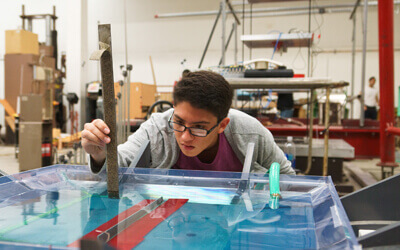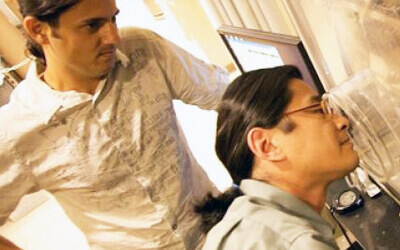
Not exactly Pharoah size: 30 micrometer five-sided pyramid
Researchers at the USC Information Sciences Institute have demonstrated a way to manufacture minuscule containers that might be used to deliver precise micro- or even nano- quantities of drugs.
The Voxel team – consisting of Will, professor of chemistry Bruce Koel (who has since gone to Lehigh University), former post-doctoral researcher Alejandro Bugacov and former grad student (now graduate) Rob Gagler folded a number of different shapes, including four- and five-sided pyramids, pentagonal ‘lotus’ shapes, and also simple square plates that folded over each other to make flat mini- envelopes. Will (right) has been pursuing the idea of creating voxels for many years, “way back to my days in HP labs, when I was working in Medical and Chemical applications.” The USC team designed the chips using MEMSPRO CAD software; the actual chip fabrication was done in France.
Will (right) has been pursuing the idea of creating voxels for many years, “way back to my days in HP labs, when I was working in Medical and Chemical applications.” The USC team designed the chips using MEMSPRO CAD software; the actual chip fabrication was done in France.
“The experimental work was done on campus,” said Will, “since ISI doesn’t have a wet lab.”
The National Science Foundation supported the research, under an exploratory research grant. The paper is “Voxels: volume-enclosing microstructures,” J. Micromech. Microeng. 18 (2008) 055025.
Below: additional images and schematics:




Published on May 1st, 2008
Last updated on August 5th, 2021











